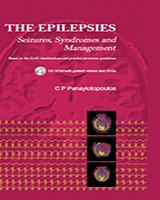From: Chapter 10, Idiopathic Generalised Epilepsies

NCBI Bookshelf. A service of the National Library of Medicine, National Institutes of Health.

This woman was referred for a routine EEG because she had experienced “probable IGE-absences from age 9 until age 18 years. Myoclonus as a teenager when sleep deprived. Recently suffered her first ever GTCS following sleep deprivation. No absence or myoclonus for 10 years. Treatment with valproate was withdrawn at age 18 years despite continuing myoclonic jerks and absences.” The video EEG documented that she still had brief absences, which manifest with mild impairment of cognition and eyelid jerks. These were spontaneous, or induced by hyperventilation (top) and intermittent photic stimulation (bottom).
Note the multiple spike–wave of the discharges and the irregular intradischarge frequency (magnification on the bottom). Also note the bifrontal spike-slow wave discharges (upper right).
From: Chapter 10, Idiopathic Generalised Epilepsies

NCBI Bookshelf. A service of the National Library of Medicine, National Institutes of Health.